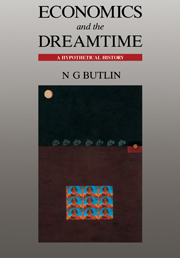Book contents
- Frontmatter
- Contents
- Preface
- Acknowledgements
- Figures
- Maps
- Tables
- Introduction
- Part I The palaeoeconomic history of Aboriginal migration
- Part II Development, structure and function of Aboriginal economy
- Part III Disease, economics and demography
- Part IV The establishment of a bridgehead economy: 1788–1810
- Part V The takeover process: 1788–1850
- 19 Introduction
- 20 British development in the long run
- 21 The hunter gatherers of empire
- 22 British, American and Macassan presence in the takeover
- 23 The major players
- 24 Aborigines and British law
- 25 The economics of takeover
- 26 The composition and demographic impact of disease
- 27 The interaction of disease with resistance, integration and submission
- 28 Conclusions
- Bibliography
- Appendix 1 Preliminary model/checklist of Aboriginal migration to Australia
- Appendix 2 NOAA depth contour maps
- Index
22 - British, American and Macassan presence in the takeover
Published online by Cambridge University Press: 06 July 2010
- Frontmatter
- Contents
- Preface
- Acknowledgements
- Figures
- Maps
- Tables
- Introduction
- Part I The palaeoeconomic history of Aboriginal migration
- Part II Development, structure and function of Aboriginal economy
- Part III Disease, economics and demography
- Part IV The establishment of a bridgehead economy: 1788–1810
- Part V The takeover process: 1788–1850
- 19 Introduction
- 20 British development in the long run
- 21 The hunter gatherers of empire
- 22 British, American and Macassan presence in the takeover
- 23 The major players
- 24 Aborigines and British law
- 25 The economics of takeover
- 26 The composition and demographic impact of disease
- 27 The interaction of disease with resistance, integration and submission
- 28 Conclusions
- Bibliography
- Appendix 1 Preliminary model/checklist of Aboriginal migration to Australia
- Appendix 2 NOAA depth contour maps
- Index
Summary
Aboriginal control of the Australian continent was, in fact, affected from three different directions. British entry at Botany Bay on the east coast in 1788 was followed within a decade by American whalers and sealers initiating their activities on and off the south-east coast and in Tasmania (Steven, 1983). In this, they were soon joined by the British (including persons from the Botany Bay settlement). Both groups followed, in time, Macassan fishing visits that spread their presence along substantially the whole of the northern coastline from the Kimberleys to Cape York (Macknight, 1976). These Macassan visits, in search of trepang, may have been regular annual ones for perhaps as long as a century before 1788 and may have been sporadic well before then. By 1788, it appears that the Macassans had only very recently completed their westward extension of fishing as far as Cape York into the eastern side of the Gulf of Carpentaria. As the British settlement spread from Botany Bay north and south along the coast, to Van Diemen's Land (Tasmania) in 1803, into the plains of eastern Australia after 1813, to Moreton Bay (Queensland) in 1824, to Fort Dundas, Raffles Bay and Port Essington (Northern Territory) in 1824, 1826 and 1838, to Swan River (Western Australia) in 1829, Port Phillip (Victoria) in 1835 and to Adelaide (South Australia) in 1836, this movement of settlers was simplified by the effects that whalers, sealers and the Macassans had on the Aborigines, even though the dominant intervention was British.
- Type
- Chapter
- Information
- Economics and the DreamtimeA Hypothetical History, pp. 196 - 198Publisher: Cambridge University PressPrint publication year: 1993



